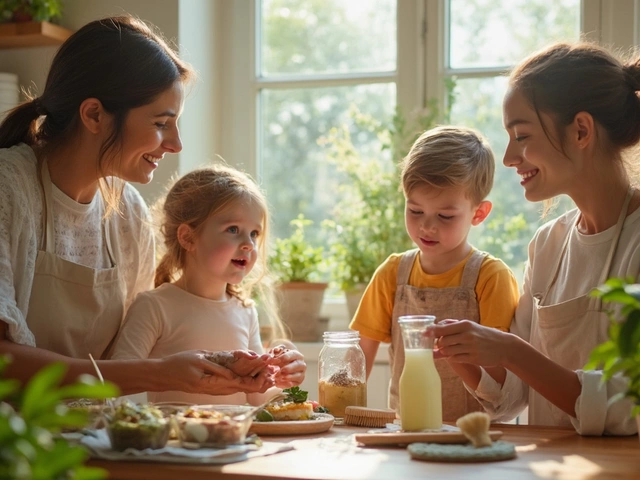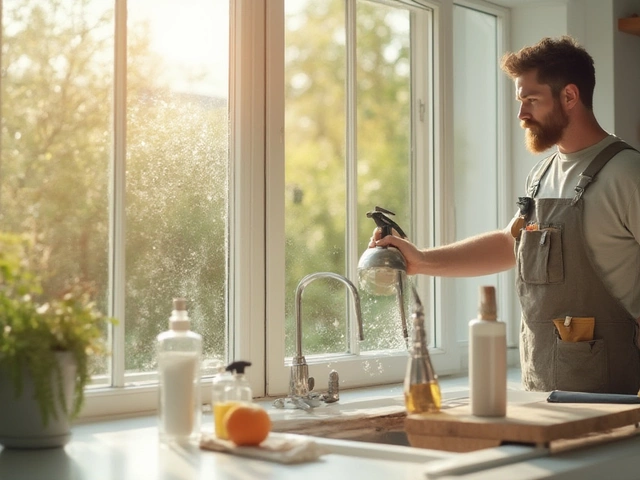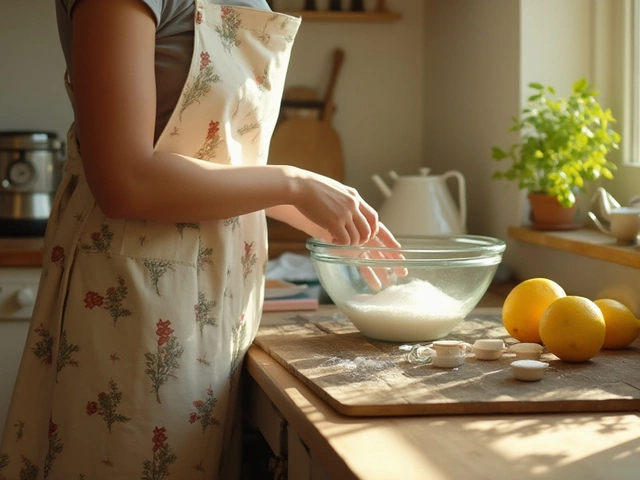Ever stood in the cleaning aisle, baffled by the labels shouting 'eco-friendly,' 'natural,' and 'green'? You're not alone. It's easy to feel overwhelmed and unsure if the product in your hand is truly good for the planet or just a clever marketing ploy. So, how do you cut through the noise and ensure you're picking the right product? Let's explore.
For starters, understanding what 'eco-friendly' really means can go a long way. It isn’t just about what’s not in the product—like phosphates or harsh chemicals—but also what's inside. Ingredients should be biodegradable and have minimal environmental impact. Think vinegar, baking soda, or plant-based surfactants.
Now, let's talk certifications. Seeing a recognized eco certification on a bottle can give you confidence that the product meets certain environmental standards. Labels like 'EU Ecolabel' or 'Cradle to Cradle' indicate that the product has passed rigorous testing. It's more than just a leaf icon; it's a sign of credibility.
But what if the label doesn’t have that trusty stamp? Fear not! You can still figure things out by checking the ingredients list and looking for jargon like ‘biodegradable’ or ‘sustainably sourced.’ Also, steer clear of vague terms like ‘plant-based’ without clear details.
- Understanding Eco-Friendly Claims
- Key Eco-Certifications
- Reading Between the Lines on Labels
- Practical Tips for Choosing Green Products
Understanding Eco-Friendly Claims
It's one thing to see the word 'eco-friendly' on a product, but understanding what it truly means is a whole other ball game. So, let's break it down. When a product claims to be eco-friendly, it should be designed to have minimal impact on the environment, from the ingredients it uses to how it's packaged.
What Makes a Product Eco-Friendly?
An eco-friendly product typically avoids harmful chemicals. Gone are the days of phosphates and parabens. Instead, you might find ingredients like citric acid or plant-based surfactants. These are not only less damaging to aquatic life but also break down quicker in our environment.
These products often have biodegradable packaging. Plastic is being ditched for recycled or compostable materials. You may also notice concentrated formulas—less packaging, less carbon emission, thanks to less transport weight.
The Jargon: Deciphering Claims
It’s vital to be wary of vague promises. Terms like ‘natural,’ ‘green,’ or ‘non-toxic’ are used freely. The key is looking for specifics. Does it list organic ingredients? Does the brand have a transparent ingredient supply chain?
Beware of Greenwashing
Greenwashing is when products give a false impression of being sustainable. Flashy green colors or nature imagery on packaging don't guarantee a product is actually eco-friendly. It's about substantiated claims, not just appearances.
Labels You Can Trust
We touched on certifications earlier, but they’re worth stressing again. The 'EU Ecolabel', 'Green Seal', and 'Cradle to Cradle' are reliable labels. Products with these stamps have met a set of transparent, externally-verified criteria.
| Certification | Criteria |
|---|---|
| EU Ecolabel | Products must have minimal energy use and waste production. |
| Green Seal | Focus on reducing toxic exposure, waste reduction. |
| Cradle to Cradle | Products are designed for a continuous lifecycle. |
Understanding these claims means diving a little deeper into what brands promise and how they deliver. It's about being savvy with the choices we make for our homes and the planet.
Key Eco-Certifications
Navigating the world of eco-friendly cleaning products can feel like you're walking through a jungle of claims. Luckily, certain badges and labels can act as your trusty guide, pointing you to sustainable and safe choices. But with so many certifications out there, how do you know which ones matter?
EU Ecolabel
The EU Ecolabel is a top-tier certification recognized across Europe. This label ensures that products meet high environmental standards throughout their lifecycle, from raw material extraction to disposal. If you see this label, the product has been vetted to be less harmful to ecosystems and human health.
Cradle to Cradle
This certification focuses on a product’s entire lifecycle, promoting a circular economy where waste is minimized. Products with this label are designed for a sustainable future, aiming for zero waste by encouraging materials to be reused rather than disposed of. It’s a solid choice if you're looking for something truly sustainable.
Energy Star
While more commonly associated with appliances, Energy Star certification can apply to some cleaning products too. It indicates energy efficiency in production and suggests that resources were used wisely, helping you cut down on energy consumption.
How Green is it, Really?
When in doubt, flip that bottle around and check for these certifications. An easy tip—certified products often list these prominently because they know savvy consumers are looking for them. Remember, just because something looks green doesn't mean it is, so these stamps of approval can help keep you informed.
To give you a clearer picture:
| Certification | Focus |
|---|---|
| EU Ecolabel | All-around sustainability |
| Cradle to Cradle | Circular economy and zero waste |
| Energy Star | Energy efficiency |
So, next time you're picking a cleaning product, let these labels be your guide. They take a lot of guesswork out of choosing something that’s truly eco-friendly.

Reading Between the Lines on Labels
Labels can be tricky. They often hide the reality behind a curtain of buzzwords and half-truths. When it comes to choosing eco-friendly cleaning products, understanding labels is crucial.
Check for Ingredient Details
The first step in decoding a label is to look at the ingredient list. Products with a ton of unpronounceable chemicals might not be your best choice. Instead, aim for labels that clearly list natural ingredients, like vinegar or baking soda.
Beware of Greenwashing
Manufacturers love throwing buzzwords like 'natural' or 'green' around. But here's the catch: They're often meaningless without context. Check if there's any detail backing these claims. Terms like 'non-toxic' and 'biodegradable' should be supported by concrete evidence or certifications.
Look for Specific Claims
- Sustainable Ingredients: Look for terms mentioning sustainably sourced or renewable resources.
- Certified Labels: As mentioned, certifications from organizations like the EU Ecolabel can be reliable indicators.
It's also worthwhile noting that sustainable packaging counts. Products touting recyclable or biodegradable packaging add to their eco-friendly credentials.
Understanding Symbols and Icons
Symbols like the Mobius loop indicate recyclability. If a product proudly displays it, it means there's some responsibility towards reducing plastic waste. However, empty signs mean nothing without proper explanation, so make sure these symbols have proper context.
| Label Term | Meaning |
|---|---|
| Biodegradable | Breaks down naturally within a short period |
| Non-toxic | Free from harmful chemicals (but specifics matter!) |
Next time you pick up a bottle, take a few seconds to dig deeper. Trust me, finding a truly eco-friendly product is worth the effort, both for you and the planet.
Practical Tips for Choosing Green Products
Choosing eco-friendly cleaning products can feel a bit like navigating a maze, but it doesn't have to be that complicated. Here are a few straightforward tips to make your life easier and help the environment too.
Check for Certifications
Don't just go by what's written on the front of the package. Flip it over and look for reliable eco certifications like the 'EU Ecolabel' or 'Leaping Bunny' if you’re concerned about animal testing. These logos mean that the product has been independently verified to meet certain eco-friendly standards.
Read the Ingredient List
Ever tried reading the back of a cleaning bottle? It’s not just for science nerds. A quick scan can tell you a lot. Look for simple ingredients like vinegar and baking soda, and avoid hard-to-pronounce chemicals.
Avoid Phosphates and Chlorine
Products with phosphates and chlorine can be harsh on the environment. They’re hard to break down and often end up in our water supply. Opt for something plant-based instead.
Prioritize Refillable Options
We all want to cut down on waste. Buying refillable bottles not only helps the planet but also tends to be cheaper in the long run. Plus, it's a great way to live a more sustainable lifestyle without sacrificing cleanliness.
DIY Sometimes Pays Off
Making your own cleaning products can be a fun alternative if you're into DIY projects. A simple mix of vinegar, water, and essential oils can tackle a lot of messes effectively. Granted, it doesn't work for everything, but for day-to-day cleaning, it does the trick.
Feel free to use these tips next time you're shopping, and remember, every small change counts.




